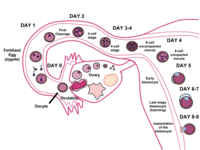
Photo from wikipedia
One of the challenges usually needs to be addressed in animal embryo production is to create the appropriate in vitro culture to improve blastocyst rate and produce high quality embryos. The… Click to show full abstract
One of the challenges usually needs to be addressed in animal embryo production is to create the appropriate in vitro culture to improve blastocyst rate and produce high quality embryos. The present work was undertaken to investigate the impact of uterine epithelial cells and its conditioned medium (CM) on in vitro embryo production in buffalo. Buffalo uterine epithelial cells (UECs) were successfully isolated, cultured and characterized from slaughterhouse derived non gravid uteri. The well-characterized first passage UECs monolayer was exposed to steroid hormones (progesterone 3.14 ng/ml and estradiol-17β 5 pg/ml) supplemented fresh culture media and after 72 h conditioned media (CM) was harvested. Morula stage embryos were cultured in steroid supplemented modified synthetic oviductal fluid (mSOF-control), co-cultured with steroid treated UECs (T1) and CM of steroid treated UECs (T2). The attachment of single or clumps of variable sizes of UECs was observed after 24-48 h culture. The UE culture attained confluence with the formation of a tight, compact monolayer having the typical cuboidal shape in 7-8 days The UECs showed positive for cytokeratin and negative for vimentin expression on immunocytochemistry (ICC) and PCR assay. Blastocyst and hatching rate were evaluated on day 09 post IVF. Blastocyst rate in the T1 group was significantly higher (p < 0.05) followed by T2 than the control group. The hatching rate in both T1 and T2 groups were significantly higher (p < 0.05) as compared to control and no significant difference was observed between T1 and T2. Thus, it can be concluded that in vitro co-culture of embryos with steroid treated UECs and their CM improved the blastocyst rate as well as hatching rate. UECs and its secretions are essential to establish uterine receptivity and to mimic the internal in vivo environment.
Journal Title: Theriogenology
Year Published: 2022
Link to full text (if available)
Share on Social Media: Sign Up to like & get
recommendations!